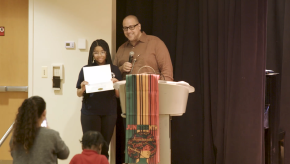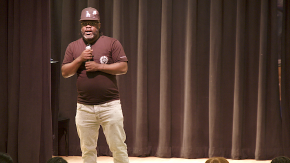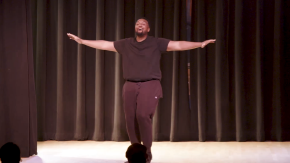
The Bronx Community Solutions team brought together the community and local artists to celebrate Juneteenth with a resource fair and performances that centered Black experience, resilience, and pride.
On a busy street just off Fordham Road in the Bronx sits the most visited library in all of New York City, the Bronx Library Center. Here residents, artists, social service providers, and our own Bronx Community Solutions team gathered to celebrate Juneteenth with art, performance, and a resource fair.
Long observed among Black communities in the South, the holiday commemorates the moment on June 19, 1865, when enslaved African Americans in Galveston, Texas, received word of their freedom—nearly three years after President Abraham Lincoln signed the Emancipation Proclamation.

Senator Gustavo Rivera took the stage to congratulate the winners of Bronx Community Solutions’ art contest.
In the Bronx, the evening began with a reception where community members helped themselves to free food, books, and festive T-shirts and wristbands. Right in the same room, social service providers—including housing specialists from our Bronx Community Solutions—set up tables with pamphlets and information about local resources, ready to offer their help to anyone in need of it.
The night then turned to local performances in celebration of Black freedom and culture.

Kicking off the night was Fearless Vizion, a Bronx-based dance team from CompSci High School, who graced the stage with an energetic dance routine to hip-hop classics touching on Black pride and resilience.

Next up was Ian Manuel, a poet and creative nonfiction writer whose work gives expression to his experience growing up in prison and solitary confinement, where he spent 18 consecutive years after receiving a life sentence as a teenager. One poem he recited, which shares a title with his book “My Time Will Come,” reads:
Like an acorn caught up in a storm,
Flung from the branch where it was born,
You can only hold me back for so long.
My time gon’ come

Actor Anthony Holiday took the stage next to perform Alethea Pace’s “Between Wave and Water,” a dramatic memorialization of enslaved African Americans buried in Hunts Point, Bronx. Pace is a Bronx-based multidisciplinary artist and choreographer whose art explores themes of social justice and collective responsibility.

To close out the night, Jose Ortiz—aka “Dr. Drum”—led an ensemble of singers, dancers, and percussionists for a bomba performance, a style of African-derived music and dance developed in Puerto Rico during the early colonial period.
As the beat of the drums carried the night to its conclusion, the ensemble invited those in the audience to join in on the singing and dancing. “The education of the drum is a different education,” said Ortiz. “It’s an education of the heart. An education of humanity.”
Through music, dance, theater, and poetry, we collectively reflected on what Juneteenth represents: the promise of freedom, equality, and humanity and the hard work that remains to be done in the pursuit of racial justice.

